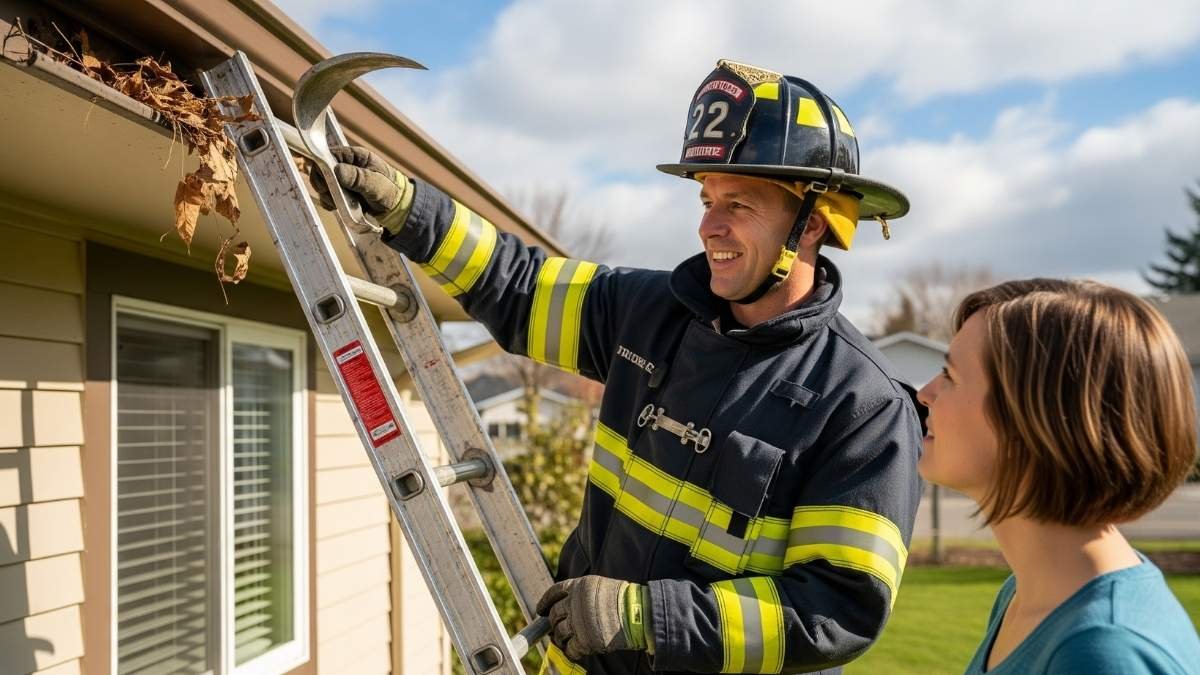
You’re sipping your morning coffee, watching the news about another devastating wildfire. “Thank goodness that’s not happening here,” you think. But what if I told you that the biggest fire threat to your home isn’t miles away in some distant forest? It’s probably sitting right above your head, collecting leaves in your gutters.
Here’s a stat that’ll make you spit out that coffee: A house fire starts every 93 seconds in America. And here’s the kicker—35% of homeowners have no clue that their clogged gutters are fire traps waiting to happen.
Sounds dramatic? Let me break down why firefighters are begging you to clean your gutters, and why this simple chore could save your home (and your life).
Wait… My Gutters Can Catch Fire?
🔥 Ember to Inferno: The Fire Pathway Timeline
I get it. You’re probably thinking, “Come on, they’re just gutters. How dangerous can a few leaves be?”
Here’s how dangerous: 90% of homes destroyed in wildfires don’t burn from the actual fire front. They burn because of tiny embers that land in—you guessed it—debris-filled gutters.
Think of your gutters like a campfire pit that someone forgot to clean out. All that dried stuff up there? It’s not just an eyesore. It’s kindling.
The Science Behind the Scare
Research by the Insurance Institute for Business and Home Safety shows something terrifying: wind-blown embers can travel over a mile from wildfire sources. That’s like an ember starting in your downtown area and landing at your suburban home.
Once these flying sparks find your gutters, they hit the jackpot. Laboratory testing proves that common gutter debris ignites at surface temperatures of just 400-500°C. To put that in perspective, that’s about as hot as a pizza oven.
And those innocent-looking pine needles? They’re nature’s napalm. Their high surface area and resin content make them “extremely hazardous” fuel beds that can generate enough heat to ignite most building materials.
Bottom line: Your gutters aren’t just collecting debris. They’re building a fire starter kit.
The Moment Firefighters Knew We Had a Problem
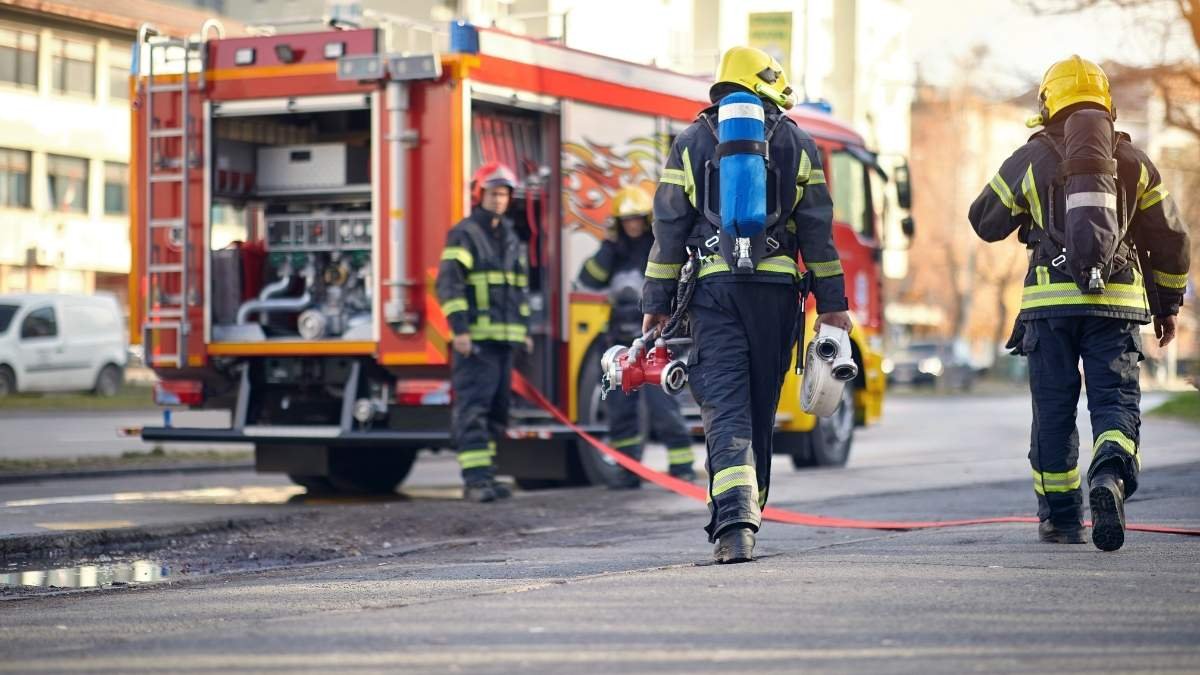
L.A. Fire Chief Kristin Crowley didn’t mince words when asked if the city failed its residents in wildfire preparation. Her answer? “Yes.”
That’s not a politician’s dodge. That’s a fire chief being brutally honest about a system that’s overwhelmed and underfunded.
Since 2010, Los Angeles has:
- Closed 6 fire stations
- Lost 68 firefighters
- Watched call volume double
“We are screaming to be properly funded,” Crowley stated. But here’s what she didn’t say directly: While fire departments struggle with resources, homeowners can take one simple action that dramatically reduces fire risk.
Clean. Your. Gutters.
Fire Chief Mark LaMont from Idyllwild put it perfectly: “We don’t have a wildfire crisis. We have a crisis of planning and prevention.”
The Marshall Fire: When Gutters Became Ground Zero
💥 Marshall Fire Impact: Destruction by the Numbers
🏠 Structures Destroyed
Homes lost in Denver area alone
🌪️ Wind Conditions
Peak wind speeds recorded
🎯 Primary Cause
Landed in flammable debris
🔥 Gutter Material Risk
Vinyl gutter melting point
Fire Spread Pattern:
Ember → Gutter Debris → Fascia Board → Roof Decking → Entire Structure
Let me tell you about Boulder County, Colorado, December 30, 2021. The Marshall Fire turned a normal winter day into a nightmare, destroying over 1,000 homes in the Denver area.
Want to know what investigators found when they dug into why some homes burned while others survived?
Flammable rooflines, including debris-filled gutters, were among the most prominent factors in home losses.
University of Colorado scientist Jennifer Balch didn’t sugarcoat her findings. Denver residents, she warned, are “sitting ducks” due to fire risks from accumulated gutter debris.
How Your Home Burns (The Scary Truth)
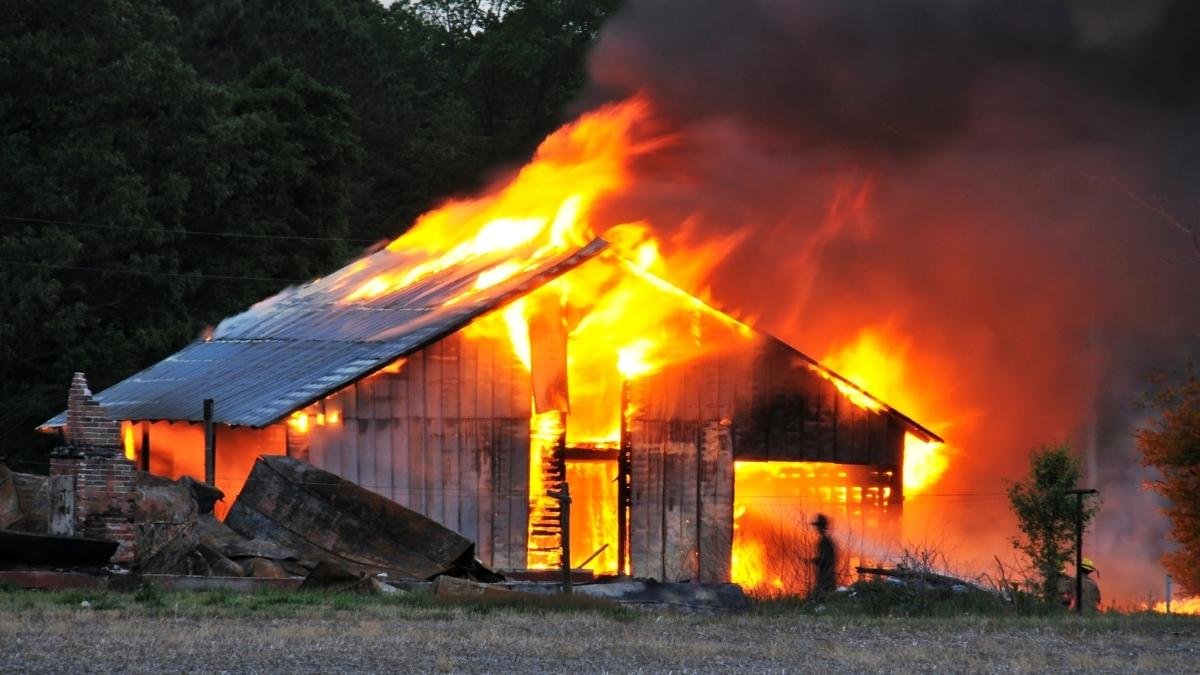
Fire investigators have documented what they call the “ember to gutter to roof and rest of building” pathway. Here’s how it works:
- An ember lands in your debris-filled gutter
- The debris catches fire and burns steadily
- Heat spreads to fascia boards and roof decking
- Your entire house becomes fuel
One documented case showed a 3-foot-wide ember traveling one-quarter mile and successfully igniting combustible materials. That’s not a movie special effect. That’s physics.
If you have vinyl gutters, the situation gets even scarier. They melt at just 160°C and detach from buildings during fires, falling to the ground while still burning and creating new fire sources below.
Your Location Matters More Than You Think

California leads the nation with over 2 million properties at wildfire risk—nearly triple the second-highest state. But gutter fire hazards aren’t just a West Coast problem.
Colorado faces particularly dangerous conditions due to high winds. 53% of properties face major wildfire risk over the next 30 years. Those mountain winds that make Colorado so beautiful? They’re also perfect for launching embers into your gutters.
Regional Building Codes Tell the Story
Here’s how seriously different states take gutter fire prevention:
California: Building Code Chapter 7A now mandates that “roof gutters shall be provided with the means to prevent the accumulation of leaves and debris” in all Fire Hazard Severity Zones.
Colorado: Requires noncombustible gutter covers in high-risk areas after the Marshall Fire lessons.
Texas: Takes a more voluntary approach despite having nearly 717,000 properties at wildfire risk.
The seasonal timing is crucial, too. Fire seasons have lengthened significantly due to climate change. Peak danger periods coincide exactly with when your gutters fill up: spring winds deposit winter debris, and fall brings leaf-drop season.
What Firefighters Do (And You Should Too)
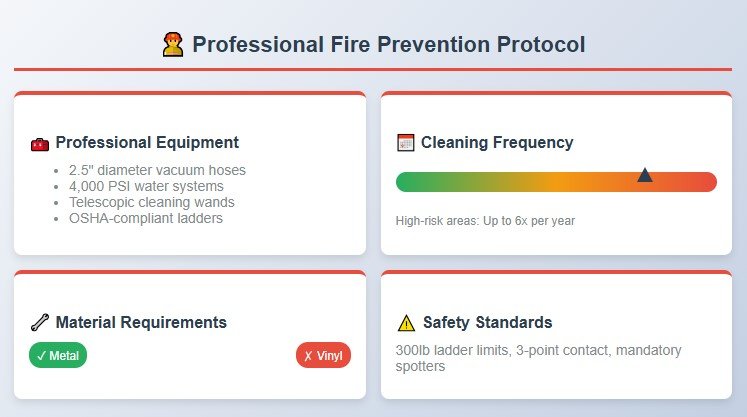
Austin Fire Department doesn’t mess around. They explicitly recommend “installation of gutter screens along with regular gutter cleaning to help protect your home from wildland and structural fires.”
But professional fire prevention goes way beyond just grabbing a ladder and scooping out leaves.
The Professional Approach

Fire departments universally require metal gutters over plastic in high-risk areas. Why? Metal systems stay in place during fires, while vinyl gutters become moving fire hazards.
Professional cleaning protocols include:
- OSHA-compliant ladder safety (300-pound weight limits, proper angles)
- Specialized vacuum systems with 2.5-inch diameter hoses
- High-pressure water systems (4,000 PSI capability)
- Telescopic cleaning wands for comprehensive debris removal
How Often Should You Clean?
Here’s where most homeowners get it wrong. You’re probably thinking twice a year, right?
CAL FIRE requires continuous debris-free maintenance throughout fire seasons. Some high-risk areas demand weekly inspections.
Fire Safe Marin puts it bluntly: “A tiny handful of leaves is enough to burn your home.” In extreme risk areas, professionals recommend up to six cleanings per year.
That might sound excessive, but consider this: each cleaning takes 2-3 hours and costs around $167. Compare that to losing your home.
The Numbers That’ll Change Your Mind
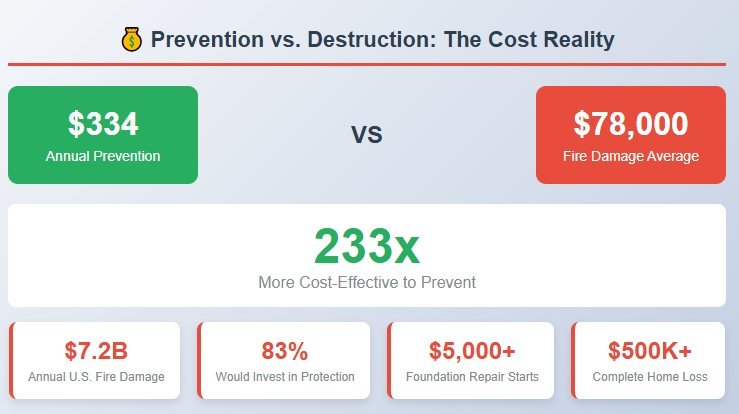
Let’s talk money. Because sometimes that’s what it takes to get people’s attention.
Annual gutter maintenance: $334 Average house fire damage: $78,000
That makes prevention 233 times more cost-effective than dealing with the consequences.
Even if you go all-out with gutter protection systems, you’re looking at $15-$45 per linear foot for installation. Complete gutter replacement averages $4-$30 per linear foot.
Compare that to fire damage costs:
- Foundation damage repair: starts at $5,000
- Water damage claims: average $13,954
- Complete home loss: can exceed $500,000
What Insurance Companies Know

Home fires cause $7.2 billion in U.S. property damage annually. Insurance companies aren’t stupid—they’re starting to offer premium discounts for homes with documented gutter protection systems.
LeafFilter’s 2025 survey found that 83% of homeowners would consider investing in fire-ready gutter solutions once they understand the risks. The demand is there. The question is: will you be proactive or reactive?
The New Technology That’s Changing Everything
🚀 Ember Protection Technology Breakthrough
Traditional Screens
New Mesh Systems
🔬 NIST Research
Computational fluid dynamics modeling
📏 Mesh Specifications
2mm apertures, non-combustible materials
🌪️ Wind Tunnel Tested
20% turbulence intensity simulation
🏗️ Building Code Updates
California Chapter 7A compliance
Recent advances in ember-resistant gutter protection represent a genuine breakthrough. We’re not talking about your grandfather’s screen system here.
Non-combustible mesh systems with 2mm apertures block 95% of dangerous embers. This technology emerged from serious research by the National Institute of Standards and Technology (NIST) using computational fluid dynamics.
The Science Made Simple
Researchers used wind tunnel studies with 20% turbulence intensity to reproduce real wildfire conditions. They discovered that pine needles with surface areas of 400-800 cm²/g create extremely high fire spread potential.
Translation: Those innocent pine needles in your gutters are designed by nature to catch fire and spread it rapidly.
The engineering breakthrough involves understanding exactly how embers behave in the wind around buildings. This isn’t guesswork anymore—it’s precise science applied to save homes.
Your Game Plan: What to Do Right Now
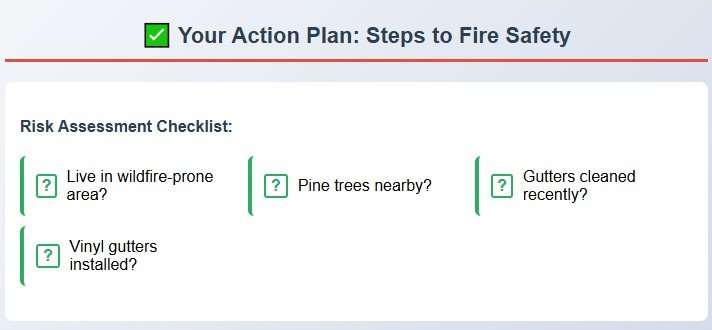
Okay, I’ve scared you sufficiently. Now let’s fix the problem.
Step 1: Assess Your Risk Level
- Do you live in a wildfire-prone area?
- What types of trees surround your home?
- When did you last clean your gutters?
Step 2: Choose Your Protection Strategy
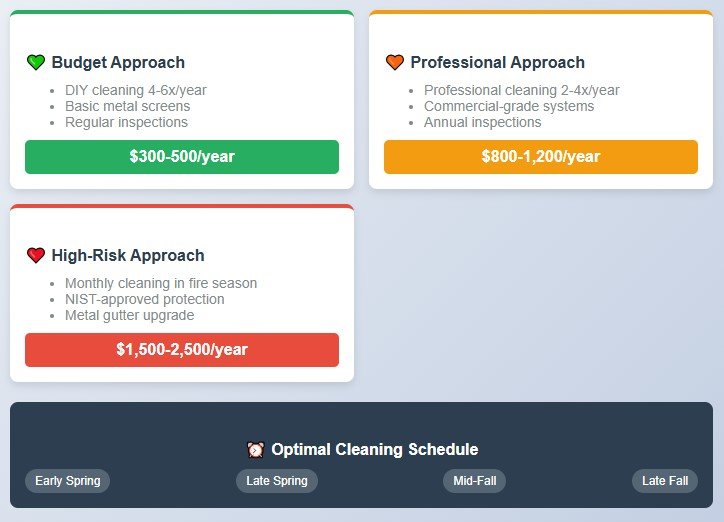
Budget-Conscious Approach:
- Clean gutters yourself 4-6 times per year
- Install basic metal gutter screens
- Maintain a consistent inspection schedule
Professional Approach:
- Hire professional cleaning service (2-4 times annually)
- Install commercial-grade ember-resistant systems
- Include gutter maintenance in annual home inspection
High-Risk Area Approach:
- Monthly professional cleaning during fire season
- Install NIST-approved ember protection systems
- Consider replacing vinyl gutters with metal systems
Step 3: Make It Routine
Set calendar reminders. Treat gutter cleaning like changing smoke detector batteries—it’s not optional home maintenance, it’s life safety equipment.
Best timing:
- Early spring (clear winter debris)
- Late spring (after tree pollen season)
- Mid-fall (during leaf drop)
- Late fall (final pre-winter clearing)
The Bottom Line: Your Choice, Your Home
Here’s the reality check: A house fire starts every 93 seconds in America. Climate change is making fire seasons longer and more intense. Urban expansion into wildland areas is putting more homes at risk.
But you’re not helpless.
The $334 you spend annually on gutter maintenance could save your home. It’s one of the highest-return investments in fire prevention available to any homeowner.
Fire Chief Crowley’s warnings about preparation failures echo across every fire-prone region in America. While she’s fighting for funding and resources, you have the power to dramatically reduce your vulnerability.
The science is crystal clear. The statistics are undeniable. The professional recommendations are unanimous.
Clogged gutters represent a fire hazard that no homeowner can afford to ignore.
In a world where embers can travel over a mile to find accumulated debris, the question isn’t whether to clean your gutters. The question is whether you can afford not to.
Ready to protect your home? Start by walking outside and looking up at your gutters right now. See leaves or debris? That’s your fire risk staring back at you. Don’t wait for fire season to remind you—schedule that cleaning today.
Your home, your family, and your peace of mind are worth far more than the cost of keeping those gutters clean.






